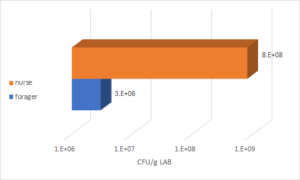Background:
Honey bees (Apis mellifera) are a super organism – functioning as a highly organized, social group of insects to support the reproductive efforts of the queen, whose job is to keep the hive alive with a constant supply of new bees. Once the queen lays eggs, it is up to the workers to determine whether the larvae become workers or a queen. Larvae introduced to pollen will mature into a worker bee. If the workers continue to supply the larvae with royal jelly, a queen will emerge. Queen bees are fed a constant supply of royal jelly throughout their lifetime to maintain fecundity. Royal jelly offers complete nutrition with added antioxidant, antimicrobial and immunoregulatory benefits (Anderson et al. 2018).
Pollen is converted internally into vitellogenin and stored in fat bodies of worker bees. Vitellogenin (glycolipoprotein) is an immune boosting, nutritionally rich superfood capable of reducing oxidative stress and promoting detoxification (Anderson et al. 2018). Vitellogenin is transported from the hemolymph into the head glands of workers to produce royal jelly for larvae and the queen (Anderson et al. 2018). The queen bee, fed a consistent diet rich in vitellogenin, reaps the greatest anti-aging benefits. The royal jelly diet also cultivates a unique gut microbiota for the queen compared to workers.
A recent publication addresses age-based microbial succession in workers and queen honey bees.
Hypotheses tested (Anderson et al. 2018):
1) Lifespan differences in a social insect model are associated with age-based microbial succession.
2) Biological age differs from chronological age.
3) Accrual of oxidation products in aging queens is associated with differences in the microbiota
Methods (Anderson et al. 2018):
1) Queens of different age groups (young, old) were sampled (n=63) from geographically different locations (CA; n=32, AZ; n=31). Results were compared to known age worker bees obtained from recent publications. Queen age microbiota was identified using 16s rRNA from four different locations in alimentary tract (mouth parts, midgut, ileum and rectum), each unique in pH and O2 concentration. Bacterial cell counts were normalized using qPCR and rRNA gene copy number.
2,3) Quantified protein oxidation using carbonyl accumulation in abdominal fat body tissues of queen honey bees as a biomarker for aging.
Results:
Results from DNA analysis demonstrates the influence of diet on microbial succession and longevity in workers and queen honey bees. Queen and worker bee gut microbiota are largely inverse of each other (Table 1). As worker bees age and transition into foragers, the gut microbiota alters significantly as the foragers are confronted with external stressors, oxidative stress and weakened immune system. Lactic acid bacteria (LAB) was isolated from nurse bee abdomens and compared to foragers at the Strong Microbials Inc. laboratory in Milwaukee, Wisconsin. Nurse bees LAB abundance in gut contents were 8.0×108 CFU/g in comparison to foragers 3.0×106 CFU/g (Table 2). It is important to supplement hives with probiotics to keep high concentrations of beneficial LAB to help worker bees live longer and stronger. Not only does the abundance shift as nurse bees’ transition into foragers, but also the composition.
As worker bees age, their microbial gut contents decrease in Lactobacillus and Bifidobacterium species, increasing in Proteobacteria associated with aging and disease in mammals (Hansen et al. 2012). Inversely, the aging queen gut microbiota decreases Proteobacteria and increases in Lactobacillus and Bifidobacterium (Table 2). Vitellogenin in royal jelly, in addition to immunoregulatory lactic acid bacteria, prevent colonization of pathogenic bacteria and act as sinks to mitigate oxidative stress accumulation, therefore extending the queens’ lifespan and fecundity.
| Age Increase | Microbial Decrease | Microbial Increase |
| Worker | Bifidobacterium spp.
L. firm 5 L. firm 4 |
Acetobacteraceae Alpha 2.1
Bartonella apis Proteobacteria |
| Queen | Acetobacteraceae Alpha 2.1
Parasaccharibacter apium Proteobacteria |
L. firm 5
Lactobacillus kunkeei Bifidobacterium spp. |
Table 1. Age-associated microbial succession in aging workers and queen.

Table 2. Comparison of microbial abundance in nurse and forager bees.
References:
Anderson, KE; Ricigliano, VA; Mott, BM; Copeland, DC; Floyd, AS; Maes, P. 2018. The queen’s gut refines with age: longevity phenotypes in a social insect model. Microbiome 6:108. https://doi.org/10.1186/s40168-018-0489-1
Hansen, Richard; El-Omar, Emad M.; Hold, Georgina L.; Mukhopadhya, Indrani; El-Omar, Emad M; Hold, Georgina L. 2012. IBD—what role do Proteobacteria play? Nature Reviews Gastroenterology & Hepatology , 2012, Vol.9(4), p.219-230
